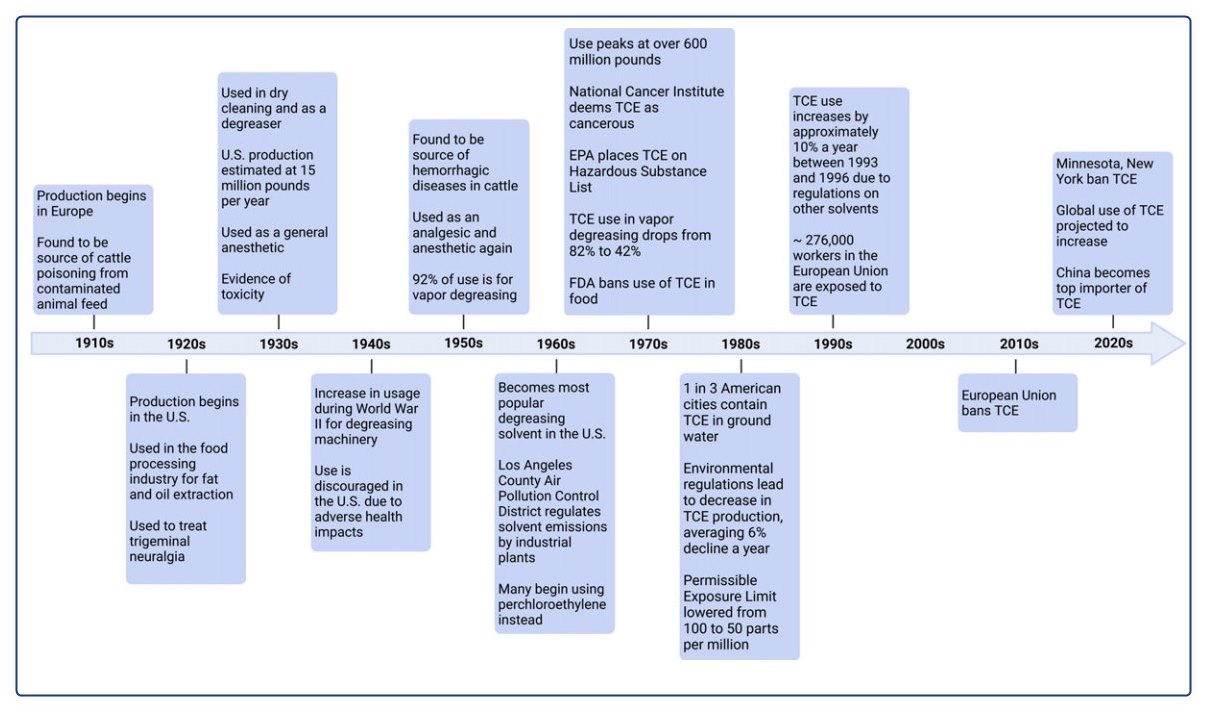Parkinson's Disease 5X more likely if Trichloroethylene (TCE, wonder about Vit D)
Trichloroethylene: An Invisible Cause of Parkinson’s Disease?
Journal of Parkinson's Disease, vol. 13, no. 2, pp. 203-218, 2023 DOI: 10.3233/JPD-225047
Dorsey , E. Raya; b; 1; * | Zafar, Maryama; 1 | Lettenberger, Samantha E.a | Pawlik, Meghan E.a | Kinel, Dana; b | Frissen, Myrthec | Schneider, Ruth B.a; b | Kieburtz, Karla; b | Tanner, Caroline M.d | De Miranda, Briana R.e | Goldman, Samuel M.f | Bloem, Bastiaan R.c

The etiologies of Parkinson’s disease (PD) remain unclear. Some, such as certain genetic mutations and head trauma, are widely known or easily identified. However, these causes or risk factors do not account for the majority of cases. Other, less visible factors must be at play. Among these is a widely used industrial solvent and common environmental contaminant little recognized for its likely role in PD: trichloroethylene (TCE). TCE is a simple, six-atom molecule that can decaffeinate coffee, degrease metal parts, and dry clean clothes. The colorless chemical was first linked to parkinsonism in 1969. Since then, four case studies involving eight individuals have linked occupational exposure to TCE to PD. In addition, a small epidemiological study found that occupational or hobby exposure to the solvent was associated with a 500% increased risk of developing PD. In multiple animal studies, the chemical reproduces the pathological features of PD.
Exposure is not confined to those who work with the chemical. TCE pollutes outdoor air, taints groundwater, and contaminates indoor air. The molecule, like radon, evaporates from underlying soil and groundwater and enters homes, workplaces, or schools, often undetected. Despite widespread contamination and increasing industrial, commercial, and military use, clinical investigations of TCE and PD have been limited. Here, through a literature review and seven illustrative cases, we postulate that this ubiquitous chemical is contributing to the global rise of PD and that TCE is one of its invisible and highly preventable causes. Further research is now necessary to examine this hypothesis.
📄 Download the PDF from VitaminDWiki
Clipped from PDF
Commercial & Consumer Products
Adhesives, Aerosol cleaning products, Carpet cleaner, Cleaners and solvent degreasers, Cleaning wipes, Cosmetic glues, Decaffeinated coffee, Film cleaners, Glue, Gun cleaner, Fumigant, Hoof polishes, Inks, Lubricants, Mold release, Paint and paint removers, Pepper spray, Pesticides, Refrigerant, Sealants, Stain removers, Tap and die fluid, Toner aid, Tool cleaners, Typewriter correction fluids, Wood finishes,
Industry Usage
Automotive care, Dry cleaning, Degreasing, Furniture care, Manufacturing, Computer and electronics, Disinfectants, Dyes, Fat and oil extraction, Flavor extracts (spices, hops), Jewelry, Machinery, Paint and coating, Paper, Perfumes, Plastics, Refrigerant*, Soaps,
Medicine
Anesthesia (medical, dental, veterinary), Surgical disinfectant, Treatment (migraines, trigeminal neuralgia), Pharmaceutical manufacturing,
- * Common current uses.
Workplace exposure
Aircraft maintenance workers, Automotive factory workers, Communications equipment repairers, Computer specialists, Corrosive control technicians, Distillery workers, Dry cleaners, Electronic component manufacturers, Embalmers, Food manufacturers, Insecticide manufacturers, Jet engine mechanics, Leather manufacturers, Machinery installation & assembly workers, Mechanics, Metal treatment workers, Missile technicians, Nautical equipment workers, Oil processors, Painters, Pesticide manufacturers, Pharmaceutical manufacturing factory workers, Printers, Radar technicians, Refrigerant manufacturers, Resin workers, Rubber cementers, Sewerage workers, Silk screeners, Shoe makers, Systems technicians, Taxidermists, Textile manufacturers, Textile and fabric cleaners, Tobacco denicotinizers, Waste treatment workers, Weapons specialists, Varnish workers
VitaminDWiki – Interactions with Vitamin D contains
{include}VitaminDWiki - Overview Parkinson's and Vitamin D contains
{include}Review of study includes other research by Dr. Dorsey, principal author - March 2023
**[What’s driving the "world’s fastest-growing brain disease"? MDEdge](https://www.mdedge.com/internalmedicine/article/261866/neurology/whats-driving-worlds-fastest-growing-brain-disease?ecd=WNL_MDIQFFF_230324_mdedge)**"He noted that the rapid increase in PD incidence cannot be explained by genetic factors alone, which affect only about 15% of patients with PD, nor can it be explained by aging alone. “Certain pesticides ... are likely causes but would not explain the high prevalence of PD in urban areas, as is the case in the U.S.” Rather, “other factors” are involved, and “TCE is likely one such factor.”"
- "In addition, it’s been used in dry cleaning, although a similar chemical (perchloroethylene [PCE]) is currently more widely used for that purpose. Nevertheless, the authors noted, in anaerobic conditions, perchloroethylene often transforms into TCE “and their toxicity may be similar.”
To fill this knowledge gap, Dr. Dorsey and his coauthors of the book, “Ending Parkinson’s Disease: A Prescription for Action,” took a deep dive into studies focusing on the potential association of TCE and PD and presented seven cases to illustrate the association.
"They noted that TCE contaminates up to one-third of U.S. drinking water, has polluted the groundwater in more than 20 different countries on five continents, and is found in half of the 1,300 most toxic “Superfund” sites that are “part of a federal clean-up program, including 15 in California’s Silicon Valley, where TCE was used to clean electronics.”"
Comments on this study and how to avoid TCE - April 2023
- Natural Health 365 how to avoid
